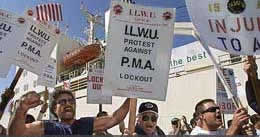The protagonists are familiar: On one side, the International Longshore and Warehouse Union (ILWU), representing more than 22,000 West Coast dock workers.
Supply Chain Digest Says... |
 |
|
Currently, just two of the 13 container terminals at Los Angeles and Long Beach have been heavily or partially automated. |
|
 |
|
What do you say? |
|
| Click here to send us your comments |
|
| |
|
| Click here to see reader feedback |
|
|
|
Opposing the ILWU is the Pacific Maritime Association (PMA), representing port and container operators in labor and other matters.
With the current contract expiring on June 30, shippers and importers are anxious for the two sides to find agreeable terms to keep the flow of goods moving – but this year’s negotiations may prove difficult in the face of rampant inflation – and as usual disputes about port automation.
The Wall Street Journal recently reported that “Automation is shaping up to be a key flashpoint” in the discussions for a new contract.
Dock workers of course see automation of container handling as a real threat to the numbers. Terminals view automation as essential to avoid more backlogs at the ports, and to improve port productivity, which in the US is at much lower levels than many terminals in Europe, Asia and the Middle East.
A port performance index created by the World Bank and S&P Global Market Intelligence ranked the Los Angeles and Long Beach port complex dead last in efficiency among the world’s ports last year.
The ILWU did agree to some additional automation in the last contract in signed 2015 and extended in 2017.
But sources inside the ILWU say this time the union will take a hardline against any further use of automated cranes, autonomous container vehicles, and other automation.
The Journal article quotes Frank Ponce De Leon, a senior ILWU official, as saying “The bottom line is that automation has killed jobs at the ports.” He added that cost savings from increased automation would go to foreign-owned container carriers.
(See More Below)
|
CATEGORY SPONSOR: SOFTEON |
|
|
|
|
|
 The ILWU in fact sees automation is an existential threat, though much more automated ports overseas still have many workers. The ILWU in fact sees automation is an existential threat, though much more automated ports overseas still have many workers.
The IWU and the PMA have agreed not to discuss the negotiations as they proceed. But if history is a guide, the contentious issue of automation will be discussed late in the process, after more routine matters such as healthcare benefits have been resolved.
Many observers think the negotiations will last into autumn, with the stevedores working without a contract (but using the current contacts terms) after the end of June.
Jim McKenna, CEO of the PMA, stated in an interview before the negotiations began that automation would be “front and center” in the talks. He cited new forecasts that the Los Angeles and Long Beach ports will hit throughput limits by 2028. The only way to keep volumes handled through the ports growing: automation. McKenna says.
The ILWU criticized the PMA for releasing that report before the negotiations began.
Currently, just two of the 13 container terminals at Los Angeles and Long Beach have been heavily or partially automated. Two more terminals have started to introduce automation, or say they plan to.
SCDigest predicts the ILWU will give little ground on this issue this time around.
What are your thoughts automation and the ILWU negotiations? Let us know your thoughts at the Feedback section below.
Your Comments/Feedback
|

